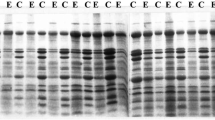Abstract
The 13–21% variation in seed protein content was observed in wild and cultivated forms of amaranth. Seed proteins of amaranth are highly nutritive and composed presumably of easily digestable albumins and globulins (over 50% of total protein); of 20.8% alkali-soluble proteins-glutelins with similar nutritive value and only of 12% alcohol-soluble proteins-prolamins which are lacking in essential amino acids. The results of polyacrylamide gel electrophoresis (buffer pH being 3.2) indicate that seed proteins of amaranth are heterogeneous and compose of 38 bands which, by their electrophoretic mobility, can be tentatively assigned to four zones: A, B, C and D. By their protein patterns all Amaranthus species were assigned to 7 biotypes. The cytogenetic and electrophoretic comparison enabled us to determine the degree of diversity among amaranth forms studied. The phylogenetic relationship between A. paniculatus L. and A. hybridus L. was confirmed. A relationship was also supposed between these two species and A. lividus L. and between A. powellis L. and A. deflexus L. which by their electrophoretic patterns belong to the same biotype. A taxonomic classification of 5 samples whose classification has not been done yet was performed, as well as of cultivars Elbrus and Progress which were assigned to specious A. edulis L. It was confirmed that the method of electrophoretic analysis of seed storage proteins is very promising for detecting the phylogenetic relationship between Amaranthus species.
Similar content being viewed by others
References
Amaranth. Modern prospects of an ancient crop. 1984. D.S. Washington (ed.) Nat Acad Press pp. 3–80.
Berdnikov, V.A. & F.L. Gorel, 1975. The study of quantitative correlations between histon fractions. Molec Biol 5: 699–705 (in Russian).
Chmeleva, S.V. & M.M. Girenko, 1989. The nourishing value of seeds of some amaranth species. In: The Results of the Scientific Research and Applied Works with Amaranth Crop L: 10–20 (in Russian).
Dubenko, S.E., 1962. The maize in the mixture with amaranth. Vestnic of the Agricultural Science 5: 93–95 (in Ukraine).
Ermakov, A.L., V.V. Arasimovich, N.P. Yarosh & M.C. Smirnova-Ikonnikova, 1987. The methods of the biochemical research in plant species. L: Agropomisdat. 430 pp. (in Russian).
Hindley, K., 1979. Aztec's winning crop-amaranth. Farmers Weekly 21: 109–111.
Konarev, V.G., 1983. A plant proteins as genetical markers. M: Kolos (in Russian).
Larin, I.V., 1951. Amaranthaceae juss Fodder plants of haymakings and pastures of the USSR. (2): 293–297 (in Russian).
Leonova, N.S., L.P. Solonenko, N.I. Contareva & O.G. Simonova, 1989. The influence of the phytohormones on the expression of genes, controllea, the protein synthesis in the callus cultures of potato. Izvestiya SO AN SSSR. Seruya Biologicheskich Nauk 1: 32–35 (in Russian).
Omeljanchuk, N.A., L.P. Solonenko & A.V. Aksenovich, 1989. Somaclonal variation in plants regenerated from callus culture of oats. Izvestija SO AN SSSR. Seriya Biologicheskich Nauk 1: 21–27.
Pal, M. & T.N. Khoshoo, 1973. Evolution and improvement of cultivated Amaranthus. VII Cytogenetic relationships in vegetable Amaranthus. Theor Appl Genet 43: 343–350.
Pal, M., R.M. Pandey & T.N. Khoshoo, 1982. Evolution and improvement of cultivated Amaranthus. IX. Cytogenetic relationship between the two basic chromosome numbers. J Hered 73(5): 353–356.
Pajim, S. & R. Chalkley, 1969. High resolution acrylamide gel electrophoresis of histones. Arch Biochem Biophys 130: 337–346.
Ryadchikov, V.G., 1978. Improvement of cereals and their evaluation. M: Kolos 368 pp. (in Russian).
Sauer, Y.D., 1967. The grain amaranthus and their relatives: a revised taxonomic and geographic survey. Ann Missouri Bot Garden 54(2): 103–137.
Solonenko, L.P., 1988. Storage proteins polymorphism as a tool in genetics and breeding. Biochemical identification of varieties: Materials III Intern Symp ISTA. Leningrad, 1987: 213–216.
Sonathon, B. & J.M. Tucker, 1986. Amaranth the once and future crop. Bioscience 36(1): 9–13.
Sozinov, A.A., 1985. Protein polymorphism and its significance for genetics and breeding. M: Nauka (in Russian).
Zheleznova, N.B., A.V. Zheleznov, V.K. Shumny & L.D. Kolosova, 1989. Outlook of cultivation of Amaranth for fodder and seeds. Siberian Vestnic of Agricultural Science 4: 49–53 (in Russian).
Zheleznova, N.B., A.V. Zheleznov, L.D. Kolosova & V.K. Shumny, 1990. Significance of amaranth pool for introduction and breeding. In: Biocenosis of Altai Region and Influence of Antropogenic Factors on them. Barnaul. pp. 27–29 (in Russian).
Zheleznova, N.B., A.V. Zheleznov, L.D. Kolosova & N.M. Shishkalova, 1990. The study of initial material for breeding amaranth under the conditions of middle altitudes of Altai. In: Genetics of Economically-valuable Characteristics of Higher Plants. Novosibirsk. pp. 200–221 (in Russian).
Author information
Authors and Affiliations
Rights and permissions
About this article
Cite this article
Zheleznov, A., Solonenko, L. & Zheleznova, N. Seed proteins of the wild and the cultivated Amaranthus species. Euphytica 97, 177–182 (1997). https://doi.org/10.1023/A:1003073804203
Issue Date:
DOI: https://doi.org/10.1023/A:1003073804203




